Rancher Takes an Unconventional Path to Restoring His Land
By Austin Price
Photography By Austin Price
Reporting Texas
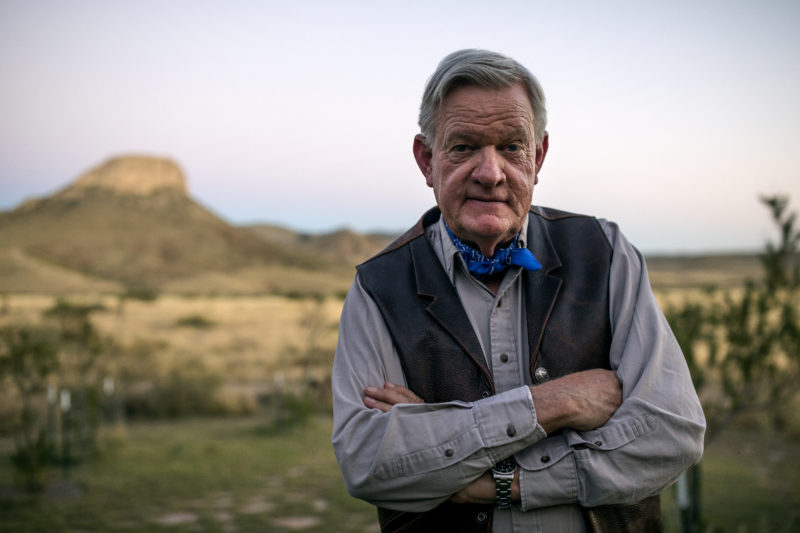
Chris Gill,72, owns Circle Ranch in West Texas. He thinks of the desert habitat, its flora and fauna, as a single system.
HUDSPETH COUNTY — Deep in far West Texas, the front-deck lights of an old ranch house shine into the desert night. Inside, Christopher Gill is drinking a Vienna-style Dos Equis after unpacking his bags from a Southwest Airlines flight he makes every other week between his home in San Antonio and El Paso. From there, it’s a two-hour drive to his home in the Sierra Diablo mountains.
Outside, howling coyotes and the screech of train wheels pierce the night. Fifteen miles separate Gill’s house from the nearest town, Van Horn, a stretch consisting mostly of shrubby badlands of creosote, ocotillo and cacti. Here and there are pockets of tall weeds, thistle and grasslands patchy from decades of overgrazing. This is the ecosystem Gill works to restore.
In 1999, Gill, his wife and their four children bought 32,000 aces in the rocky red wasteland of Hudspeth County, a region known less for conservation efforts than for swaths of private rangeland, oil rigs and 80-mph-speed-limit highways. Gill, 72, a former developer and oil man, intended to use the land to hunt quail and deer and for family holiday gatherings, until he recognized a higher purpose as a landowner.
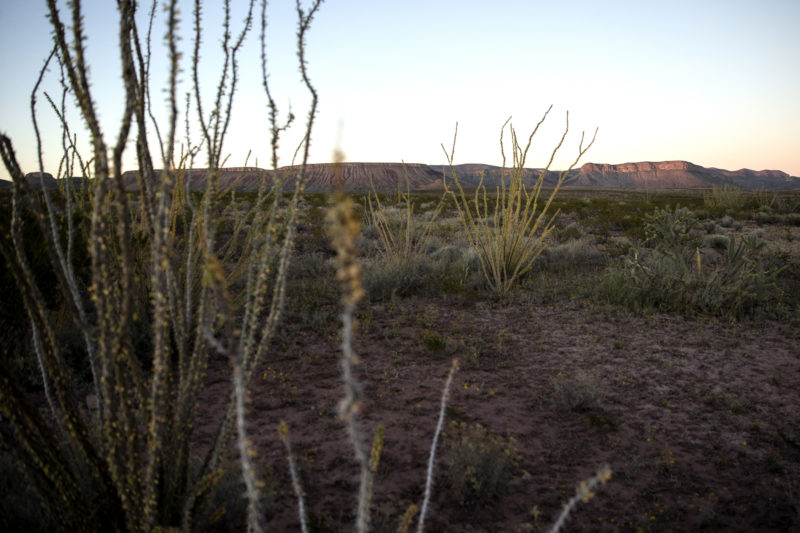
Ocotillo grows alongside thistle and other desert shurbs and cacti on Gill’s ranch.
Nearly two decades ago, Gill met Allan Savory, a rancher from Zimbabwe and promoter of a philosophy he calls holistic management. In Savory’s view, livestock can become a tool to restore the land, not the means of its destruction.
Most environmental experts view Savory as a heretic. They say his approach is not based on science or sound research and can do more harm than good. The U.S. Department of Agriculture has criticized his claims that the right grazing practices can be good for the land.
But Gill became a convert. He is now both a rancher and a conservationist, though not quite in the conventional sense of either.
“In a nutshell, I think the whole problem is that we don’t view these systems as interdependent, integrated, inseparable wholes of animals, plants, soil,” he says. “It’s one system, but we’ve broken these things down to these super specialized areas of knowledge, and nobody really has the big picture.”
Gill doesn’t mind ruffling feathers. He goes against the grain of both conventional cattle ranchers, who view grasslands as a resource and wild predators as a nuisance, and many conservationists, who see livestock as part of the problem rather than part of the solution. Both sides, argues Gill, call for the unnecessary exclusion of one species to help another.
“We’ve been trained to think that there’s a chemical for every problem in agriculture, and a bullet,” he says. “We just pound the shit out of nature all the time.”
But selling the Savory approach in West Texas can be difficult, Gill says.
“There’s an embedded mentality that goes this way: ‘I’ve been doing this all my life. My father and grandfather did it before me. I don’t need to be told what to do…by some rich guy from San Antonio.’ And my response is, well, ‘You guys damaged the ranges like hell.’ ”
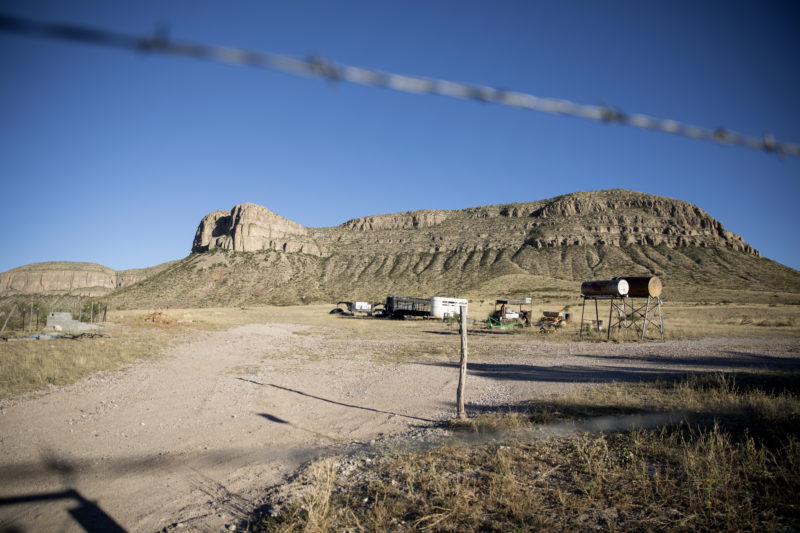
Rocky buttes tower over the ranges surrounding Circle Ranch headquarters.
In the morning, Gill puts on a leather vest and boots, pours himself a cup of bold coffee and heads out to a pasture. He takes long strides through the patchy grass spotted with weeds.
“You see that? That’s a cow track,” he says, pointing out where his cows have broken up the soil. Earlier that week, he had brought a hundred head into this single acre to graze for a couple of days. He says many ranchers would call that overgrazing. In much of America’s rangeland, livestock are left to graze constantly on plants, eventually killing them, and compacting the soil with their trampling.
Gill believes the solution is simple: “We can control the timing,” he says. “And with control of the timing, you get the plants getting healthier.”
He preaches planned rotational grazing, which he says will improve pastures instead of destroying them. Rotational grazers move their herds from section to section throughout the year, giving plants a chance to recover. The method is inspired by the mechanics of a natural grassland ecosystem, in which large herds of grazers such as bison and elk constantly move across the plains. They keep the grasses closely cropped, which allows other weeds to grow as feed and habitat for birds and other wildlife. The herd also breaks up the soil, spreading seeds as they stomp and defecate. Rain collects in the naturally tilled soil and helps the grasses recover before the cattle return.
The goal is what followers of Savory call regenerative agriculture — rancher and livestock interacting with the land to bring back what has been lost.
“Anybody that says cattle aren’t beneficial for plants doesn’t understand plants,” Gill says.
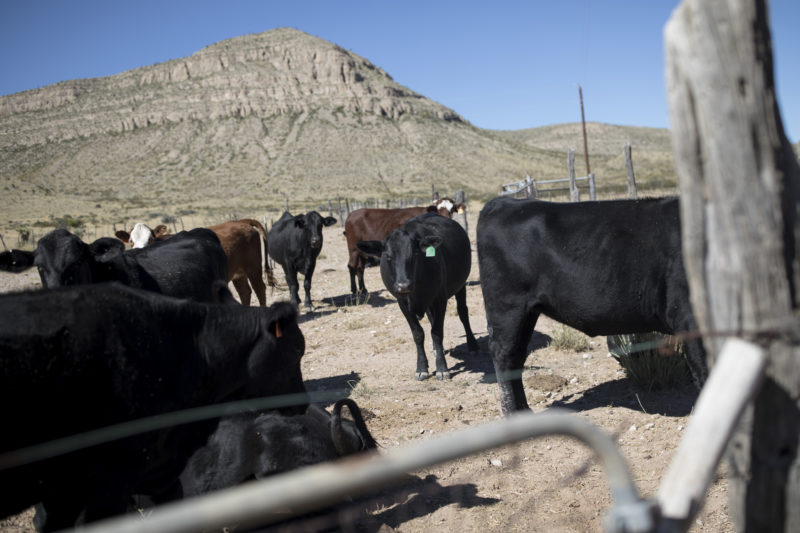
Cattle crowd a gate before being released to graze the pasture near Circle C Ranch headquarters.
Gill never thought he’d become a ranching conservationist. He earned a degree from the Wharton School of Business at the University of Pennsylvania and went into business. His wife, Laura, is from a ranching family extending to the days of the Republic of Texas.
They bought their ranch almost two decades ago with no intention of running cattle. But a chance encounter changed Gill’s mind.
“To make a long story short,” he says, “I met Allan Savory.”
Shortly after buying the ranch, Gill received an invitation from his friend John Poindexter, who owns Cibolo Creek Ranch near Marfa, to come over and meet Savory.
Gill recalls the message from his first meeting with Savory: “Picture Africa. Picture the mixed herds. They’ve co-evolved over millions of years. Now the plants need the animals as much as the animals need the plants.”
In 2013, Savory gave a TED Talk and brought attention to the philosophy he had formed through decades of research — that conventional livestock practices, not the livestock themselves, have degraded our environments and wildlife habitats. He points out parallels to the savannas of his native southern Africa, where Savory says he’s witnessed the successes of holistic management, to grasslands near his current home in Albuquerque and in the rest of the American West, where overgrazing has caused significant loss in biodiversity and productivity.
He urges ranchers to run their land as if it were a natural ecosystem — run cattle like a herd of buffalo. Allow cattle to graze but move them on to new sections. That helps plant diversity and wildlife habitat.
Savory’s prescription: “Only livestock can save us.”
Savory has promoted his views through Holistic Management International, based in New Mexico, which has hosted workshops on Circle Ranch, and the Savory Institute in Colorado. Both organizations have planted the seed of holistic management in Texas, where 95 percent of the land is in private hands, meaning private owners hold the key to the health of the land.
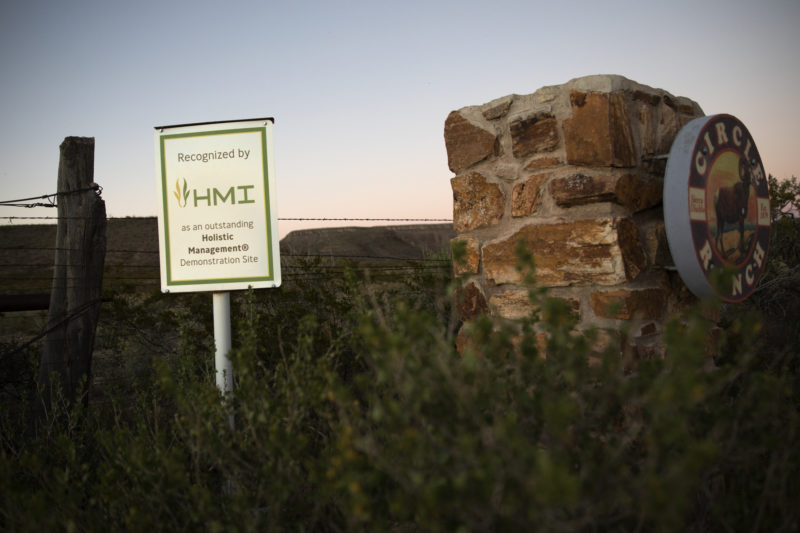
A sign designates Circle C Rand as a demonstration site for holistic management, an unconventional approach to land conversation.
“We personally have found that it’s been more profitable to ranch holistically rather than the conventional method,” says Rhona Lemke, a rancher and holistic management educator in Mason, about 100 miles west of Austin. “You’re building denser grasslands, which benefits your animals and, therefore, your profit margins.”
Along with another ranching couple, the Lemkes run Grassfed Sustainability Group, the only “accredited hub” in the Savory Institute Network in Texas, and teach holistic ranching through workshops and consultations with landowners.
Chad Lemke is a fifth-generation Texas rancher, the first to switch from conventional ranching to holistic management. He spent much of his life working in landscaping in San Antonio before returning to the family ranch: “I joke and tell people ‘I used to grow grass to cut, and now I grow grass for animals to eat.’ It’s not that much different.”
When Gill first met Savory at Poindexter’s ranch, he had an easy response to all the talk about biodiversity, soil life and livestock’s place in the cycle: “I said, ‘Shit, that makes sense.’”
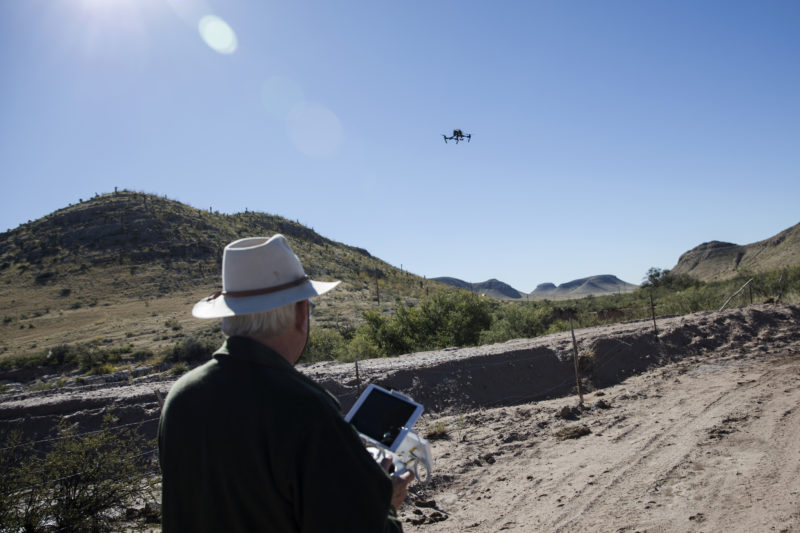
Gill uses his drone to monitor his land and share photos to promote holistic management practices.
Gill pulls out his camera, unpacks a drone from his truck and sends it buzzing over the pasture. Like other holistic ranchers, he documents the changes on his land and spreads the message of holistic management through his blog, circleranchtx.com, which he writes from an office filled with Mexican Civil War photographs and Texas history books.
He has placed much of his trust in foreman Evidencio Seijas, a lifelong resident of the Chihuahuan Desert.
“Evi has worked this country for many, many years and he has as good an understanding of holistic principles as anybody that’s ever graduated from A&M,” says Gill. “Better; better. He gets it.”
That morning at breakfast, Seijas had told Gill in soft-spoken Spanish that a storm had destroyed one of their gully dams. “Well, let’s fix it,” Gill said. “Mas alto, mas grande.” Much higher, much bigger.
For years, the two men have dammed up gullies and plowed along the contours of their brittle land with a Yeomans plow, a tractor-pulled set of thin blades invented by P.A. Yeomans for a process he developed called keyline plowing. The idea is that water hits the dam, spills out of the gully and collects in the plow-lines as it flows downhill. This process has been adopted by many followers of Savory.
“Eleven inches of rain, that’s 10 billion gallons of rain that falls on this ranch a year. Eighty percent of it runs off or evaporates,” Gill explains. “Once water gets in the gullies, it goes from one gully to another to an arroyo and off the ranch.” Keylining enables more water to soak into the ground and stay on the ranch, he asserts.
Many areas on the ranch that were plowed in recent years show tall grasses and weeds now growing in the plow-lines. In some areas, grasses grow around creosote, which many ranchers believe to be a water-hogging shrub and chemically remove.
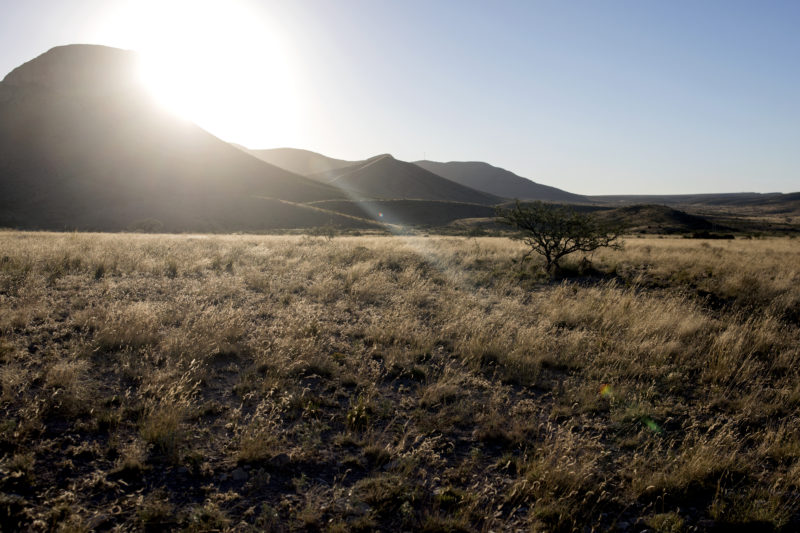
The sun rises over Circle Ranch’s 32,000 acres of open rangeland and desert habitat.
As the drone returns, Gill lifts his Ray-Bans and reviews the images: green meadows of rangeland under red mountains, surrounded by the hazy desert horizon.
Somewhere beyond the ridge lives a variety of animals, some that Gill bought and others that have naturally populated his land — various types of cattle, llamas and burros, bighorn sheep, pronghorns and quail. Predators have started to return, he says. This past summer, his motion camera caught a mountain lion near one of his wells.
At one point, he experimented with bison— the true herd grazer of the high plains — until they roamed a little too freely and caused an accident on Interstate 10. He replaced them with a herd of purebred longhorn.
Besides, says Gill, “you can’t have a ranch in Texas without longhorn.”
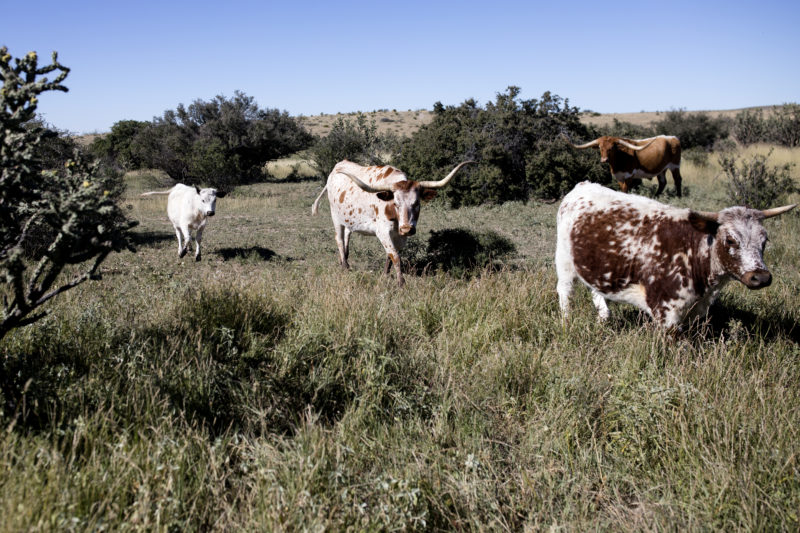
A herd of longhorn grazes a pasture on the edge of Circle Ranch.